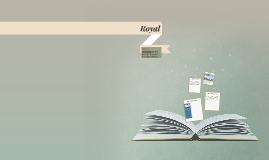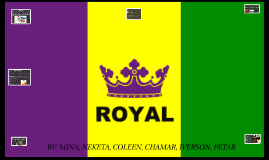ROYAL
Transcript: - HOUSE OF COMMONS & SENATOR’S The house of commons is the lower house of parliament, they are an elected body by citizens for 5 years also known as members of parliament or MPs. Royal’s parliamentary system is open and democratic. We offer the people an opportunity to give us their input and we are designed to make sure proposals for laws are carefully considered. One of the parliaments job is debating and passing laws. However, new laws can originate from an MP. Senator’s are members of the senate, and a senate is the upper house or parliament. The senators are elected by the president from university professors and judges and are approved by the house of commons for 5 years. The senate job is to debate and approve the laws that are passed from the house of commons before it gets approval from the president. BY: MINA, NEKETA, COLEEN, CHAMAR, IVERSON, PETAR ROYALS . -MINA -CHAMAR GOVERNMENT -PETAR HOLIDAYS -Your barber is fat day (September 18th) -Christmas (December 25th) -New years (January 1st) -Valentines (February 14th) -St.Patricks day (March 17th) -Labour day (September 1st) -Halloween (October 30th) -Basketball day (November 7th) -Royal's day (September 22nd) -Family day (February 10th) -Thanksgiving (October 13th) -Remembrance day (November 11th) -Boxing day (December 18th) -MINISTRIES Agriculture, Food Affairs Community Safety and Correctional Services Economic Development, Employment and Infrastructure Education Energy Environment and Climate Change Finance Health and Long-Term Care Foreign affairs Internal affairs Labour Natural Resources and Forestry Tourism, Culture and Sport Training, Colleges and Universities Transportation RIGHTS & LAWS FREEDOM & HUMAN RIGHTS ARMY - COLLEEN Rights: everyone has the right to choose their religion. Has the right to express their thought/opinion without being offensive, racist, sexist est. every one has the right to enter, remain in and leave the country, jobs should be open to everyone over 13, everyone has the right to feel equal, everyone has the right to live and have personal security Laws: in order to vote in an election, must be over 18 and a citizen, all children aged 6 to 16 must receive some form of education, abuse toward any person man woman child and animal is against the law Consequences if you broke a law: if you do not obey the law and the government finds you guilty, there will be consequences. For minor offenses such as Theft and dangerous driving, you may have to pay fines, do community services and spend a short time in prison. If it were a major offense such as hurting someone or robbing, you may go to prison for a longer time. For killing someone you may go to prison for life Reasons why we have laws: The law affects nearly every aspect of our lives every day. On the one hand, we have laws to deal with crimes such as robbery or murder and other threats and challenges to society. On the other hand, laws regulate common activities such as driving a car, renting an apartment, getting a job or getting married. -DEMOCRACY We have a democracy which is a system of government by the whole population or all the eligible members of a state so Royal’s citizens get to elect the members of parliament. -NEKETA Our Country has a population of 15 million. Royal is a small country in Europe, it is an island, and it is above the UK and under Iceland. It is a beautiful country with amazing cities and beautiful nature. It has 3 states named after the founders, one of them is called Minketa an other one is called Chamter and the last one is called Collson. -CABINET The cabinet is a body of ministers appointed by the president to head the executive departments of the government and to act as official advisers. They also run the country freedom list -people have the right to express themselves without hurting others or themselves -people have freedom of information -people have the freedom to have an education -people have the freedom to express their mind (but no assault) -people have the freedom to leave any country including his/her own and return to his/her country -people have the freedom to wear what they like -people have the freedom to adopt -people have the freedom for an abortion -people have the freedom to buy stuff example clothes houses cars etc. -people have the freedom to go places example restaurants malls etc. -people have the freedom to get married and have kids (they can also have the freedom to a divorce) -people have the freedom to get a job -people have the freedom to be who they want to be -people have the freedom to go to university and college we have the freedom to a lot but we have to be cautious of others and obey the laws human rights -all human beings are born free and are equal in dignity and rights -everyone is entitled to all the rights and freedom set forth in this declareration without distinction of any kind such as race color language religion political or other opinion national or social origin property birth or other

















